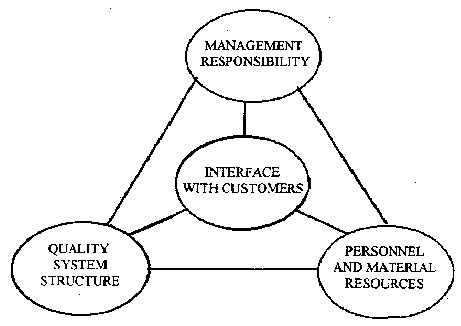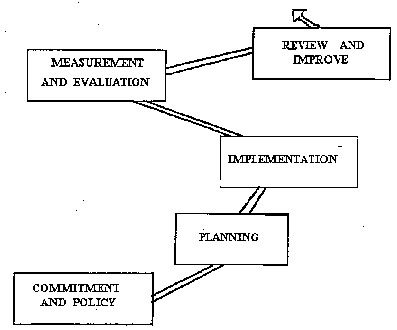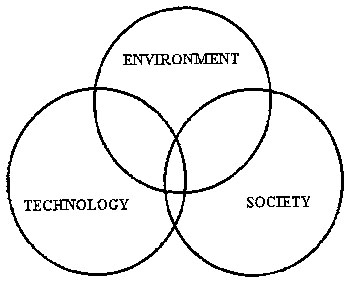
Fig. 1 - KEY ASPECTS OF A QUALITY SYSTEM up
ABSTRACT
This paper presents some of the most known methods of evaluation/accreditation of engineering courses all over the world. It also shows how we can adapt ISO 9000/14000 series to evaluate engineering education.
The challenge is to create a system of evaluation which respects cultural, historical, and economical differences and is able to adapt itself to the growing changes.
The goal is to promote discussion in order to settle some guidelines for building a world-wide recognized method of accreditation of engineering education. We aim to help engineers to be able to work in a global market and improve quality of engineering education.
In the last few decades the development of new technologies is growing faster and faster. Also economical factors are changing, and we are now facing a global, world market. The competitiveness of each company is associated with the quality of its products or services.
We are approaching the 21st century and the quality of Engineering Education (EE) has to be taken seriously. We are all concerned: enterprises, providers and students. Quality in EE is imperative to provide effective professionals for the society.
Technological development leads to increase the demand for new knowledges. Engineers have to be qualified to deal with innovations. One of the main challenges of EE is to supply the acquisition of new concepts whenever it becomes necessary. The learning process should become as "just-in-time", that means it should be always changing to answer promptly to market's needs.
The importance of continuous improvement in EE has been noticed not only by providers, but also from students and employers. Recycling knowledge is imperative to maintain company's competitiveness.
This paper presents some of the most knows methods of evaluation/accreditation of engineering courses all over the world. It also shows how we can adapt ISO 9000/14000 series to evaluate engineering education.
OBJECTIVES
The main goal of this article is to promote discussion in order to settle some guidelines for building a world-wide recognized method of accreditation of engineering education.
We are going to present some ideas of different criteria that should be considered and the importance of having all partners working together for effective evaluation.
We aim to help engineers face this new global market and improve quality of EE. Graduate engineers should be able to work in any company without major problems. They have to be prepared to adapt themselves to our actually changing global market.
As we have said before, assessment of "quality" interest providers, students and enterprises.
Actually, accreditation of EE concerns the whole society, cause they are the final clients. Each individual in our society is a client of different products and services, which become available with the help of engineers. So, quality of EE affects everyone's living conditions.
In order to recapitulate, we should consider as partners for EE courses quality certification the following categories:
ORIGINS
The nature of EE courses are diverse. The great variety of systems and courses are due to the different cultures, legislations, technologies, partners, etc., in summary to the environment of each course provided.
The suppliers of EE courses have to evaluate theses divergences in order to establish a system of evaluation. One of the biggest challenges of creation of EE certification is that EE courses do not have fix standards. The "game of courses", offered by suppliers, has to be continued reviewed and improved to follow technologies innovations and supply the market with its never ending new demands.
There is one thing that we must keep in our minds is that there are two systems:
- standards;
- certification.
Standards (e.g. ISO series) are made to provide guidelines for quality of products and services. Based on these guidelines the Certification Bodies create methods to assess the quality of products and services in order to attest it.
BASIC REFERENCES
ISO 9000 / 14000
lt is important to make a brief summary of ISO 9000 and of ISO 14000 to establish some guidelines to apply it in EE.
ISO 9004
Quality Management and Quality Systems Elements - Guidelines
Key-word: Quality Assurance
Goal: Ensure organizations' products and services quality
To succeed one enterprise must offer products and services that:
- have a use or application well defined;
- meet clients expectations;
- maintain high standards;
- suit society regulations;
- have competitive prices;
- can provide benefits.
A management system should consider the needs of both, clients and company. Every management system must be adapted to the product or service provided.
ISO 90042
Quality Management and Quality Systems Elements - Guidelines for Services
Key-word: Quality Assurance
Goal: encourage organizations and companies to manage the quality aspects of their
services activities in a more effective manner.
Achievement of Quality:
- Commitment to quality principals at all levels in the organization and continual
review and improvement of the established system of Quality Management based on
feedback of the customer's perception of the service provided.
Quality Management might improve:
- service;
- customer satisfaction;
- productivity;
- efficiency;
- cost reduction;
- market share.
To achieve these benefits a quality system should:
- manage the social process involved in a service;
- regard human interactions as a crucial part of service quality;
- recognize the importance of customer's perception of the organization's image,
culture and performance;
- develop skills and capability to improve quality and meet customer's expectations.
This can be summarized by the chart in fig. 1:
ISO 14000
Environmental Management Systems - General Guidelines on Principles, Systems and Supporting Techniques
Goal: provide assistance to organizations implementing or improving an environmental management system (EMS). It is consistent with the goal of "Sustainable Development" and is compatible with diverse cultural, social and organizational frameworks.
Key Principles:
- recognize that environmental management is among priorities;
- establish and maintain communications with internal interested parties;
- determine the legislative requirements and environmental aspects associated with
the
organization's activities, products and services;
- develop management and employee commitment to the protection of the
environment, with clear assignment of accountability and responsibility;
- encourage environmental planning throughout the product or process life cycle;
- establish a disciplined management process for achieving targeted performance
levels;
- provide appropriate and sufficient resources, including training, to achieve targeted
performance levels on an ongoing basis;
- evaluate environmental performance against appropriate policies, objectives and
targets and seek improvement where appropriate;
- establish a management process to review and audit the Environmental
Management System and to identify opportunities for improvement of the system and resulting
environmental
performance;
- encourage contractors and suppliers to establish an EMS.
ISO 14000 includes additional principles and elements that an organization may consider.
Basic Characteristics:
- ISO 14000 are designed to organizations of all series, and it takes care of SMEs;
- its emphasis is on prevention rather than corrective action;
- it is based on the concept of "continual improvement" (see fig.2);
- it aims to benefit in both financial and environmental terms.
Principles:
An organization pursuing EMS should follow these 5 principles:
- Principle 1: an organization should focus on what needs to be done. It should ensure
commitment to the EMS and define its policy.
- Principle 2: an organization should formulate a plan to fulfil its environmental policy.
- Principle 3: for effective implementation an organization should develop the capabilities
and support mechanisms necessary to achieve its environmental policy,
objectives and targets.
- Principle 4: an organization should measure, monitor and evaluate its environmental
performance.
- Principle 5: an organization should review and continually improve its environmental
management system, with the objectives of improving its overall
environmental performance.
These 5 principles are compatible with the spiral of continual improvement, which is presented as EMS Model (see fig.2).
EE AND EMS
EMS and life cycle concept will become the backbone in a new industrial culture named sustainable production. Sustainability means that products are planned and developed for all life cycle phases (production, distribution, use and disposal), and that we should minimize influence on the environment, occupational health and use of resources. A new concept is emerging (see fig.3). The industries now have to be responsible for the whole life cycle of its product.
This new concept emerging has to take care of 3 major points (fig.4):
- technology changes and innovations;
- influence on the environment;
- impact on society and respect for its cultural values.
When we think of EE we have to see the environment also as the society. That means technological changes' influence in cultural and social values. EE must focus on improving living and working conditions' quality. Providers must be able to anticipate and adopt a politic of prevention, which could be established by research groups linked to the institutions.
To improve EMS the 3R strategy is recommended:
1- Reduce;
2- Reuse;
3- Recycling
The main goal of 3R strategy is to reduce (material and energy). Actually, EE have to review continually their courses in order to see what is still useful. We should try to produce engineers able to think and learn by themselves, cause the technologies are changing too fast, and a professional has to be always up to date. This decade problem is not the lack, but the excess of information provided by all communication methods. To attempt the clients expectations, it is useless to give students more concepts than those they really need. This extra information is easily lost, forgotten. Professors have to be able to transmit the right amount of information, at the right time, and teach the students how to search for information by themselves without loosing to much time.
In order to implement the second step of 3R strategy EE providers should train and educate people which could become leaders, and providers of education for their colleagues or companies' team. EE should encourage the reuse of its concepts, that would than be spread, with benefits for the whole society. This learning integrated process, would in medium term leave more time for providers to prepare new subjects, maintaining the concept of having a just-in-time and continuing improving learning process
Recycling is absolutely necessary to be in the market today. The easiest way to recycle engineers is to maintain a group of CEE (Continuing Engineering Education) in order to supply graduate students with new concepts and technics that become available after they leave school. Engineers should be in contact with their universities, to be informed of what are the innovations available in the market that can they can take advantage.
CONCLUSIONS
Quality has become part of our life. The days where clients would accept anything are far away, we are all more conscious of our rights as final customers and "QUALlTY" has become imperative. This word in the last few decades has increased its value and now just being able to operate properly is not enough. In order to buy a product or a service the price, assistance, bonus, other functions available, possibilities after disposal, etc. are points to be considered. ln summary, the process to select a product or service has become much more complex than it used to be.
It is not different when we are going to choose a university to study engineering or we are going to choose a professional to work in our teams. So as providers or students there is some criteria that should be settled in order to help the selection.
The question is: What are the characteristics that EE should have to assure quality? Our proposal is to use this conference as forum to discuss this matter and establish some guidelines for a world-wide evaluation and accreditation system of EE. A EE Quality Certification could be very useful, to exchange experiences and professionals in this "global market".

Fig. 1 - KEY ASPECTS OF A QUALITY SYSTEM up

Fig. 2 - EMS MODEL - CONTINUAL IMPROVEMENT up

Fig. 3 - LIFE CYCLE up

Fig. 4 up